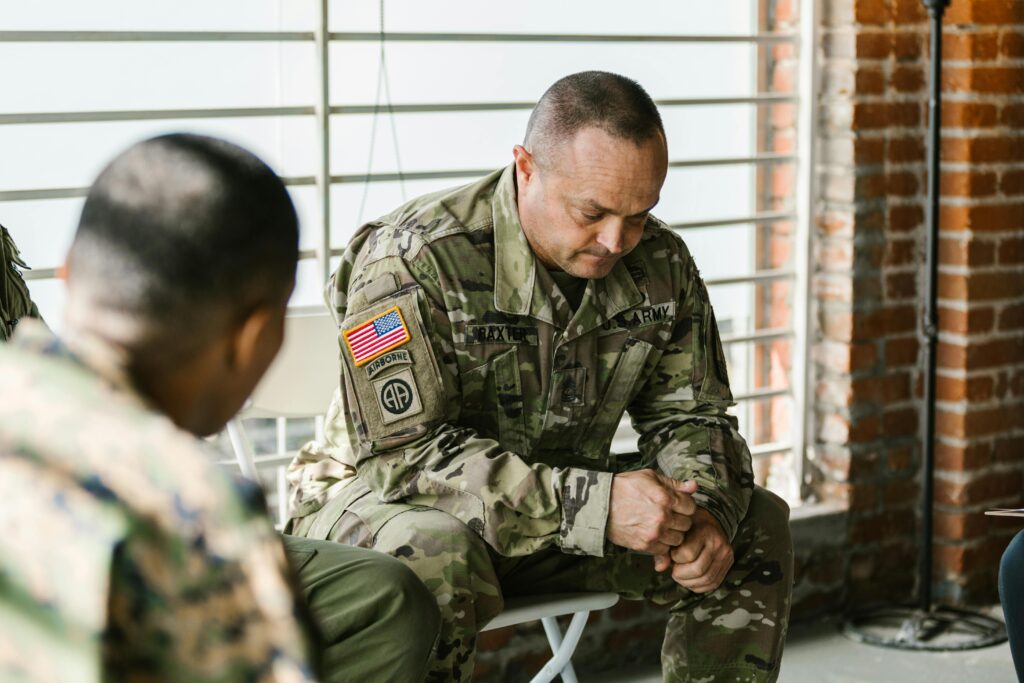By Dr Paula Davis
5 October 2025
“Stop treating your wound like it’s something you imagined. If you see the wound is real, then you can heal it.” ~ Bardugo, (2017), Crooked Kingdom
“Just as physical wounds heal at different rates in different people, so do emotional wounds. Everyone has different needs and speeds.” ~ Karen Salmansohn
“Have mercy on me, Lord, for I am faint; heal me, Lord, for my bones are in agony. My soul is in deep anguish. How long, Lord, how long? Turn, Lord, and deliver me; save me because of your unfailing love.” ~ Psalm 6:2-4

Photo by cottonbro studio: https://www.pexels.com/photo/person-in-black-jacket-and-blue-denim-jeans-sitting-on-black-couch-4100655/
When the Body Carries What the Heart Can’t Say
Pain doesn’t just live in our thoughts or feelings; it settles into our bodies. Even when we think we’ve moved on, our bodies often carry the residue of what we’ve lived through. A tightness in the chest. A clenched jaw. A sudden fatigue we can’t explain. Sometimes, without warning, a smell or a sound will send us spiralling, not because we’re weak, but because our bodies remember what our minds have tried to forget.
I used to think healing was mostly about changing how I thought or what I believed. But I’ve learned, sometimes the hard way, that our healing must also include our bodies. That the Spirit of God doesn’t just want to renew our minds or lift our souls, but to dwell with us in the flesh-and-bone places where trauma has left its mark.
In this blog post, we’ll explore how God meets us in the hidden pain our bodies carry, and how honouring that pain with compassion can become the beginning of deep, embodied healing.
The Broken Strong
In 2003, I published a peer-reviewed article exploring the connection between body and mind (adapted from Davis, 2015). At the time, I suspected a link between my own experience of physical meningitis and what I later came to call “meningitis of the soul.” The connection seemed almost too obvious to ignore. This chapter explores the intersection of physical pain and inner wounding, inviting us to consider how the body often speaks what the soul cannot yet say.
Helen Flanders Dunbar (1943, 1947), an American psychoanalyst, was pivotal in popularizing the term “psychosomatic” in the 1940s and 1950s. She proposed that the symptoms of any illness often reflect deeper, emotional wounds. I found myself thinking of this when I spoke with my adult son, who had recently dislocated his shoulder. At the time, he was going through an emotional upheaval, an inner dislocation that mirrored his physical injury. The connection between the two was striking and undeniably real.
I’ve long been drawn to body-oriented therapeutic approaches, which suggest that our bodies store the memories of pain (Ogden, Minton & Pain, 2006). During my doctoral research, I worked with war-traumatized populations, where many survivors of severe trauma reported bodily symptoms like stomach aches, symptoms that masked deeper emotional or psychological wounds. Rather than presenting with recognizable signs of depression or PTSD, they presented with pain that was far more tangible and physical.
Neurobiology supports this, confirming that the brain sometimes fails to process overwhelming traumatic events, causing the trauma’s undischarged energy to be stored in the body as “body memories” (Fisher, 2009). When individuals encounter stimuli reminiscent of the original trauma, say, a smell, sound, or colour, they can be flooded with memories and emotions. It’s as if the body is holding onto these memories for us, dragging us back to the place of pain, where the wound was first inflicted. The physiological roots of trauma are profound. A threshold is crossed when we meet our body’s pain with compassion.

Photo by RDNE Stock project: https://www.pexels.com/photo/photo-of-a-distressed-soldier-7467909/
Why Some Rise and Others Break
The year before I contracted meningitis, I went through a series of seismic disappointments, losses, disillusionments, and painful surprises that, when added together, brought me to a breaking point. Individually, each event might not have been overwhelming, but cumulatively, they created a profound emotional inflammation.
At the time, I wondered if I would ever feel normal again. It felt as though something inside me had irreparably broken. There was no quick fix, no comforting word, no medicine that could ease the throbbing in my mind, my soul, and my spirit. I had to ride it out. The swelling of grief and sorrow seemed relentless. Would body-oriented therapy have helped? Or soul work? Or spiritual intervention? How does one recover from “meningitis of the soul,” when the emotional inflammation lingers far longer than expected? And when the soul itself feels fractured, what can we do?
We often ask: What makes some people emerge from hardships stronger while others spiral into bitterness? Are challenges truly the work of the enemy, or could they be doorways that lead to greater resilience? Does wisdom grow from vulnerability? I’ve often wondered if it’s true that struggle builds resilience, deepens our vision, and transforms the spirit. It’s a question that can only be answered in the context of experience.
Pain has a strange way of unearthing what we value most, often in the most uncomfortable ways. When life crumbles, we’re forced to confront our lack of control over what matters to us most. The illusion that life will be easy shatters, and we must face the reality of our vulnerability. The grieving process is one of relinquishing dreams and hopes. Sometimes we’re called to let go of the life we thought we would have, the dreams that gave us comfort.
It’s interesting that the first step in the Twelve Step Recovery Program (Alcoholics Anonymous World Services, Inc., 2002) is admitting our powerlessness. For me, this resonates with the experience of trauma, where we are forced to face that we are powerless over events outside our control. How does one emerge from overwhelming loss and find strength?

Photo by Tima Miroshnichenko: https://www.pexels.com/photo/man-in-white-dress-shirt-sitting-on-black-chair-5710922/
Who Becomes Resilient?
The question of resilience often points back to emotional muscle. Like a physical muscle, our emotional resilience grows with use. I’ve noticed that those who face the deepest crises, like those in the aftermath of September 11 in America, seem better equipped to handle trauma. They appear more flexible, able to adjust to life’s unpredictability. In contrast, those who have lived with fewer trials tend to struggle more when the rug is pulled out from under them. Resilience isn’t simply about surviving; it’s about growing stronger in the face of adversity.

Photo by AS Photography: https://www.pexels.com/photo/closeup-photo-of-sprout-1002703/
This concept of resilience was constantly at play in my work as a trauma counsellor. As a wounded healer (Nouwen, 1979), I spent years working with survivors of war in northern Uganda and northern Sri Lanka. I began to see how profound trauma shatters not just the body, but a person’s sense of self, their safety, and their ability to control their world. It’s a humbling thing to witness how the brokenness becomes a source of new strength for some, while others are trapped in the chaos of their unresolved pain.
Trauma, especially when inflicted on a collective level, is a hard teacher. It strips a person down to their rawest vulnerability. And yet, what I have learned through years of working with survivors is that strength is often birthed in brokenness. Many survivors share that the key to recovery is opening up, to let others into their pain and give voice to their wounds. This is one of the most difficult, and often the most healing, steps in the journey.
For many of us, we are taught to hide our wounds. I was raised in a culture that valued strength as emotional control, especially in times of grief or hardship. It’s a paradox: we are told that we are weak if we show emotion, and yet, it is in our most broken moments that we discover strength we never knew we had.
In my case, my meningitis healed physically long before my soul found peace. It was an extraordinary process, one of surrender, of allowing the pain to teach me something deeper. I’m still learning how to handle life’s crises with less drama, but in this journey of brokenness, I continue to find my strength, piece by piece.
The God Who Heals
Jesus played a central role in healing physical wounds during His ministry. The name Jehovah-Rapha, meaning “the God who heals,” speaks to God’s deep desire to restore wholeness to His people. But as we see throughout the Gospels, Jesus’ healing wasn’t just about restoring the physical body; it was about holistic restoration, body, soul, and spirit.
In the New Testament, the Greek words for healing give us further insight into the breadth of God’s desire to heal:
- Sozo: This word speaks to complete salvation and restoration. While it includes physical healing, its primary focus is on spiritual restoration and deliverance. Jesus’ healing ministry encompasses the total well-being of the person (Isaiah 53:5) (Strong, 1995).
- Therapeuo: From which we derive the word “therapy,” this term refers to treating and serving the sick. Jesus demonstrated His compassion by healing physical ailments (Thayer, 1989).
- Iaomai: A more immediate, miraculous form of healing, this word often refers to divine intervention and freedom from oppression, as seen in the many instances where Jesus casts out demons and heals the body (Thayer, 1989).

Photo by Tara Winstead: https://www.pexels.com/photo/happy-birthday-greeting-card-on-white-surface-8384037/
Jesus’ healing ministry wasn’t just about fixing bodies; it was about making people whole, emotionally, spiritually, and physically. One of the most striking examples of this is the healing of the woman bent over for eighteen years in Luke 13:10-17. Jesus recognized that her physical ailment was connected to spiritual oppression. He healed both the body and the spirit, freeing her from bondage and restoring her to health.
This story is a powerful reminder that the mind, body, and spirit are interconnected. Jesus came to heal the whole person, offering not only physical restoration but also freedom from spiritual and emotional bondage.
Closing Thoughts
Jesus offers us the fullness of healing, not just in our bodies, but in our souls and spirits as well. His love and grace call us to embrace a holistic restoration, one that invites us to become whole again, so that His life can be lived fully in and through us.
But healing doesn’t stop at the surface. If our bodies carry the impact of trauma, our minds often carry the weight of it, the distorted beliefs, the anxious thoughts, the mental scripts formed in pain and self-protection. These wounds of the mind can be just as limiting, just as exhausting, and just as in need of grace.
In the next blog, we turn toward the tender and sometimes tangled space of the mind, where toxic thoughts take root, where lies can masquerade as truth, and where the battle for peace is often fought. Healing our minds means learning to recognize the patterns that keep us bound and opening ourselves to God’s renewing truth. Because when the mind begins to heal, clarity returns. Hope rises. And we begin to see ourselves, and God, with fresh eyes.
Declarations
• I declare that You, Heavenly Father, are Jehovah Rapha, my Healer. • I thank You for the truth of Your Word in Jeremiah 30:17. • I stand on the promise that You will restore health to me and heal my wounds. • I declare that this promise is alive and active in my life and the lives of my family. • I declare in the name of Jesus Christ that every stronghold that seeks to affect my physical health is broken. • I declare complete healing and restoration in every area of my body. • I claim the redemptive power of Jesus’ sacrifice over my life and my family. • I reject any curse of physical injury, sickness, or disease. • I declare that by His wounds, I am healed (1 Peter 2:24). • I declare wholeness, health, and divine protection over myself and my family in the name of Jesus. • All glory and honour belong to You, Lord.
Prayer
Blessed Jesus, in the comfort of your love, I lay before you the memories that haunt me, the anxieties that perplex me, the despair that frightens me, and my frustration at my inability to think clearly. Help me to discover your forgiveness in my memories and know your peace in my distress. Touch my physical body where trauma is stored, O Lord, and fill me with your light and your hope. Amen.
(Adapted from Healing from the Past, Church Publishing, 2000).
Reflection Questions
- As you reflect on your own life, where do you feel the pain of unhealed wounds, whether physical, emotional, or spiritual?
- In what ways do you feel God inviting you into a deeper healing?
- Write down a prayer acknowledging the areas of your life that need His touch of restoration.
Journal Prompt
Write or draw a short prayer or reflection: Where in my life, body, mind, or spirit, is God inviting me to receive His healing and become whole? Let your pen move without censoring. See what flows out.
About the Author

Dr. Paula Davis, a clinical counsellor , supervisor and educator with three advanced degrees, specialises in trauma counselling, and before she retired, was a senior lecturer in counselling, designing and delivering curricula. Her book, “Eating Water, Drinking Soup: Finding Nourishment in the Deepest Pain” is available on request. With her husband, she delivers marriage programs internationally. In 2021, they published “A Safe Place: A Marriage Enrichment Resource Manual” available on online bookstores. Paula has published articles in peer-reviewed journals and speaks at conferences and venues in Australia and internationally.

